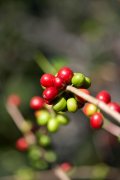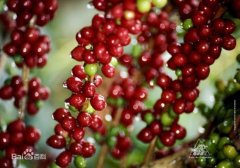Boutique Coffee Panamanian Coffee Variety Kaduai, Kaddura, 30% Rosa
Panamanian coffee originated in 1780, when European immigrants introduced the first Tipica tree species. Located in Central America, with the natural advantages of sunshine, land and mountains, coupled with a sufficient working population, the region is an excellent area for growing and producing high-quality boutique coffee, and it is a paradise for coffee. In particular, Geisha coffee from Panama has led to a global trend of paying attention to boutique coffee, which has successfully attracted global interest in Panamanian coffee. Boquete is the oldest and most famous coffee producing area in Panama. It is located on the east side of Mount Baru and is a plateau with an average elevation of about 1000-2000 meters. Among them, "Baru Volcano National Park" (Volcan Baru National Park) is an ecological conservation area, which is very rich in biodiversity and has a variety of microclimates. In addition, it is shrouded in mist all the year round and abundant rainfall, which creates good local cultivation conditions, which makes Boguet coffee with a unique aroma and is the producing area with the highest output and the best quality of Panamanian coffee. Every harvest season, coffee farmers will use the refined method of washing and drying in the sun to make the raw beans full and pure flavor.
The Baru volcano is not only the highest mountain in Panama, but the sediments created by early volcanic activity and eruption bring a large amount of very fertile soil, which is rich in nutrients, especially rich in phosphorus and sulfur, mixed with clay and unique climate patterns, making the region a suitable environment for the growth of high-quality coffee. Dense forests and a large number of species form the overall biodiversity.
About 50 coffee farmers here form a small cooperative, all of which produce coffee in the traditional way of Bogut-allowing it to grow in a near-natural environment. Although the yield is not high, it can maintain a rich ecological environment, and soil quality can be maintained or even improved. The natural planting method is not only beneficial to the environment, because the coffee fruit grows slowly, so it is easier to grow high-quality coffee beans with good flavor. Farmers harvest complete coffee berries by hand and send them to nearby Cafe de Eleta S.A. The post-processing plant is about 4 kilometers away from the farm, and a modern laboratory is set up for cup test tube and manual screening.

Important Notice :
前街咖啡 FrontStreet Coffee has moved to new addredd:
FrontStreet Coffee Address: 315,Donghua East Road,GuangZhou
Tel:020 38364473
- Prev

100% full-sun processing of high-quality Guatemalan beans on the Waiqiang plateau
This area of the Huaiqiangsi Plateau is of volcanic soil, with high altitude, sufficient rainfall and great humidity variation. Ash from Pacaya, Guatemala's most active volcano, provides important minerals for the soil in the region. There is plenty of sunshine in the dry season, and although the clouds and dew are heavy in the morning, they dissipate quickly. As a result, 100% of the coffee in the area is processed in the full sun. [characteristics] bright acidity
- Next

New Oriental Coffee growing area Guatemala Fine Coffee
New Oriental coffee in this area has been grown entirely by small farmers since the 1950s, and now every farmer in the mountains is a coffee production unit. This area, once the most remote and poorest part of Guatemala, is now alive and well. Rainy and cloudy, the ancient era of the New Oriental is a volcanic area, soil volcanic metamorphic rocks evolved, rich in minerals and nutrients.
Related
- Does Rose Summer choose Blue, Green or Red? Detailed explanation of Rose Summer Coffee plots and Classification in Panamanian Jade Manor
- What is the difference between the origin, producing area, processing plant, cooperative and manor of coffee beans?
- How fine does the espresso powder fit? how to grind the espresso?
- Sca coffee roasting degree color card coffee roasting degree 8 roasting color values what do you mean?
- The practice of lattes: how to make lattes at home
- Introduction to Indonesian Fine Coffee beans-- Java Coffee producing area of Indonesian Arabica Coffee
- How much will the flavor of light and medium roasted rose summer be expressed? What baking level is rose summer suitable for?
- Introduction to the characteristics of washing, sun-drying or wet-planing coffee commonly used in Mantenin, Indonesia
- Price characteristics of Arabica Coffee Bean Starbucks introduction to Manning Coffee Bean Taste producing area Variety Manor
- What is the authentic Yega flavor? What are the flavor characteristics of the really excellent Yejasuffi coffee beans?

